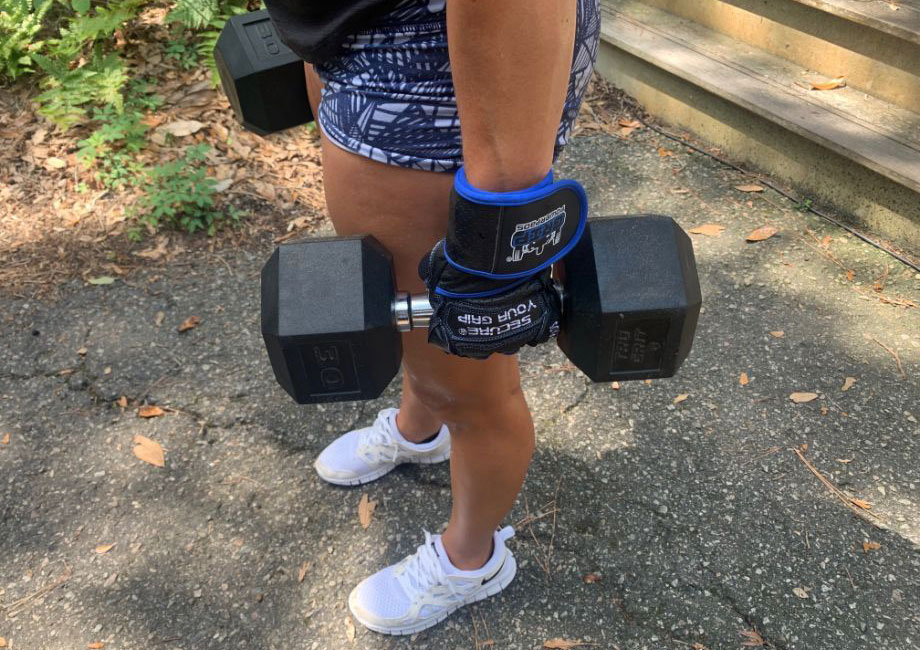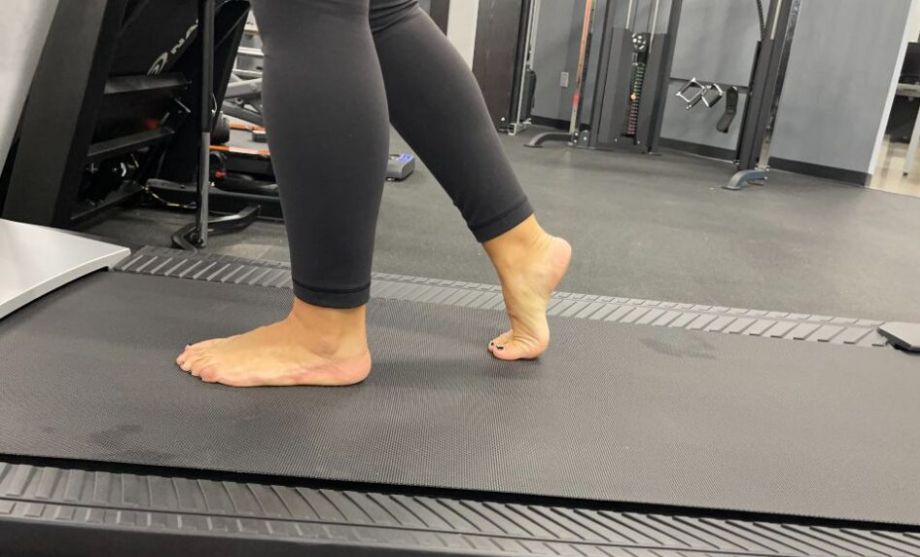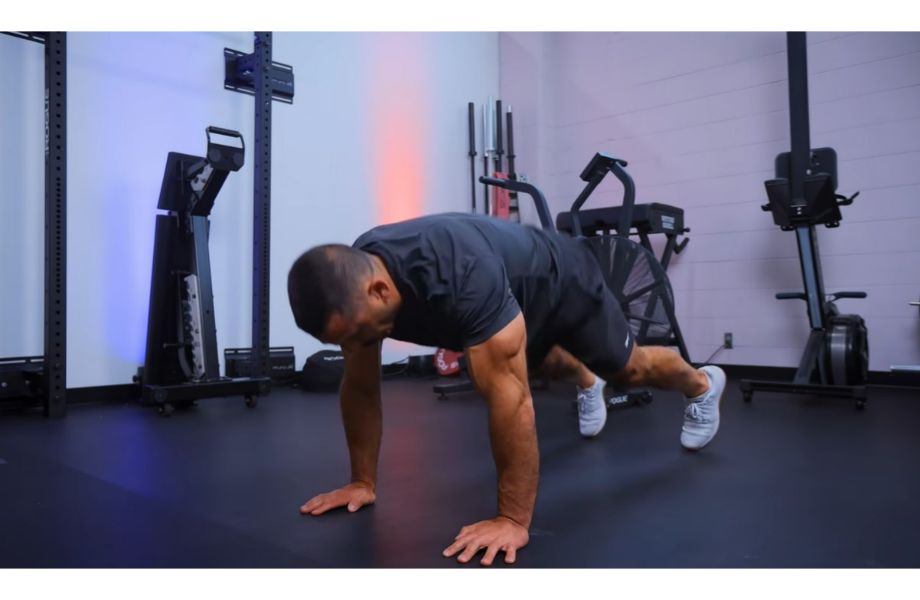Farm work involves heavy manual labor, so it’s not surprising that many farmers have strength in spades and a lean physique without having to dedicate loads of time to the gym. I mean, who needs barbells and treadmills when you’ve got a long day of chorin’ ahead of you?
Fitness aficionados figured there’s no reason the farmers should get to have all the fun, so they co-opted certain movements, namely the aptly named farmer’s walk or farmer’s carry, for use in their workout routines. Today, the farmer’s carry is more than just what a farmer does when lugging stuff around a barn. It’s also a simple, functional full-body exercise that provides activation to several muscle groups.
Caine Wilkes, OLY, USAW-L1, and GGR staff writer, breaks down this compound exercise, giving step-by-step instructions, tips for proper form, and common mistakes to avoid.
Read on for everything you need to know about the farmer’s carry!
How to Do the Farmer’s Carry
Muscles worked: Quadriceps, hamstrings, glutes, calves, latissimus dorsi, erector spinae, trapezius, biceps, triceps, forearms, core
How to do it:
- Grab two dumbbells or kettlebells and place them down on either side of your body.
- Reach down to grip the handles using a neutral grip, then deadlift the weights to your sides. In your starting position, you should have your arms fully extended at your sides, a tall chest, braced core, pinched shoulder blades, and a neutral neck and spine.
- Start walking in a straight line, taking short, deliberate steps.
- Continue walking for the desired distance or duration, then rest.
- Reset and repeat.
RELATED: Best Dumbbells
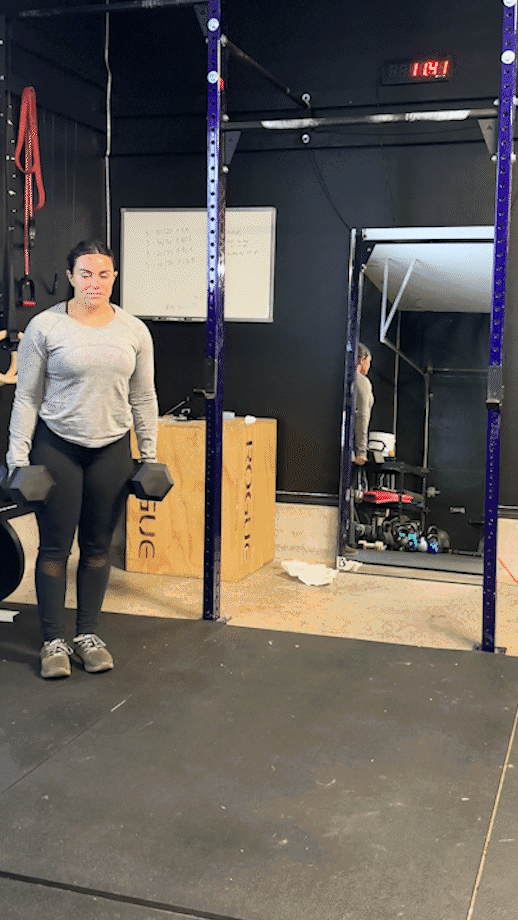
Trainer Tips for Form
Are you ready to carry yourself to better fitness? It all starts with getting that form right. Here are our top tips for performing the farmer’s carry with proper form.
Stay Slow and Steady
Remember—the exercise is called the farmer’s walk, not the farmer’s run.
Rushing through the movement is a recipe for disaster, as a single misstep could be the reason you pull your calf muscle, roll your ankle, twist your knee, or experience any of many injuries that’ll turn your farmer’s walk into a farmer’s “sit on the bench” for the foreseeable future.
“Don’t get carried away going too fast on your farmer’s carry,” says Caine Wilkes, OLY, USAW-L1. “Going slow is the best way to keep your form strong and posture tight. Plus, it also maximizes the amount of time your muscles spend under tension.”
Studies show1 that spending more time under tension results in greater strength gains and hypertrophy for your working muscle groups. So, take your time on these to reap the most benefit from each carry and minimize your risk of injury.
Brace Your Core
The farmer’s walk exercise can wreak havoc on your lower back if you’re not bracing your core. Recent studies show2 that abdominal bracing stabilizes the spine, which may reduce your risk of injury and alleviate symptoms associated with chronic low back pain.
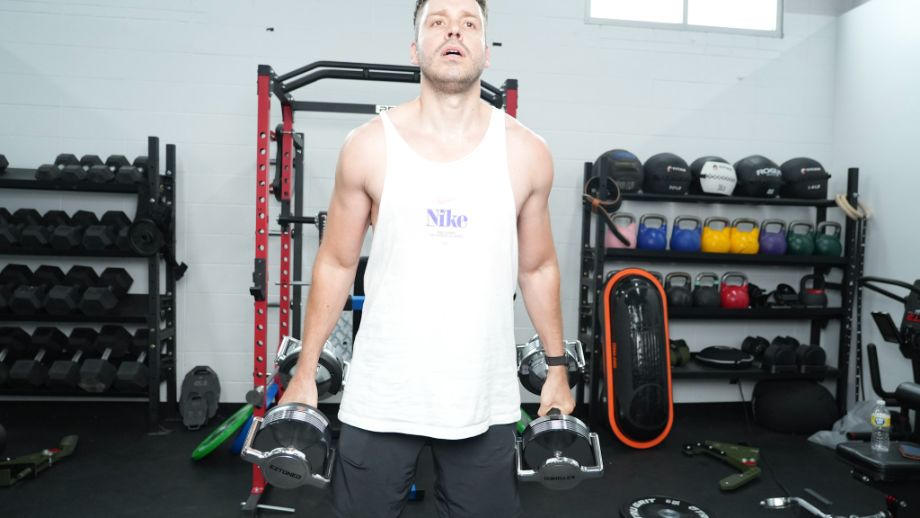
“Take a deep breath in, letting your rib cage expand, then exhale, contract your abdominal muscles, and draw the belly button towards your spine,” says Caine. “Knowing how to brace helps you manage heavy weights for the farmer’s carry, but it’s a useful technique for squats, deadlifts, and overhead presses, too.”
Get a Good Grip
The farmer’s carry tests your lower-body strength and challenges your grip strength. Without a good grip, the weights may slip from your grasp, land on your toe, bounce into your ankle, or cause some other catastrophic series of unfortunate events. Ee-i-ee-i-oh no!
You can be cavalier about picking up light weights, but farmer’s carries are meant to be heavy. Here are some of Caine’s tips for getting a good grip so you can walk without worrying about free weights flying from your fingers.
RELATED: Grip Strength Exercises
“Instead of gripping the handle of your kettlebell or dumbbell with your fingers, reach all the way down until the bottom of your palm is pushed into the handle,” says Caine. “Then, curl your hand and fingers around the handle, wrap your thumb, and squeeze hard. This grip looks the same at a glance, but, if you’re doing it right, it’ll be strong since you’ve effectively increased how much of your hand’s surface area comes into contact with the handle.”
Don’t forget to chalk up while you’re at it! Chalk is inexpensive, portable, and perfect for strength training exercises when your hands get sweaty and those heavy weights get slippery.
RELATED: Best Lifting Chalk
Farmer’s Carry Benefits
Farmers don’t need to perform loaded carries in the gym since they’re already part of their job, but what about us non-farmers? Why should we program the farmer’s carry into our workouts?
It’s a Full-Body Workout
Whether you’re a busy professional struggling to maintain a work-life balance, a parent rushing to squeeze in a workout before picking up your kids, or an athlete who needs to get the most out of every training session, time is precious. The best exercises provide a total-body workout that targets muscle groups in the upper body, lower body, and everything in between.
RELATED: Full-Body Compound Workout
That’s exactly what you get with the farmer’s carry.
Farmer’s carries target your upper body muscles like the traps, lats, bis, tris, forearms, and lower body muscles like the quads, glutes, calves, hammies, and core. Because of this, you’ll promote strength and hypertrophy gains practically everywhere.
It’s Functional
What’s even more appealing about the farmer’s carry is that, unlike technical lifts that require tons of practice and the guidance of an experienced fitness professional, you’re probably already using this movement in your everyday life.
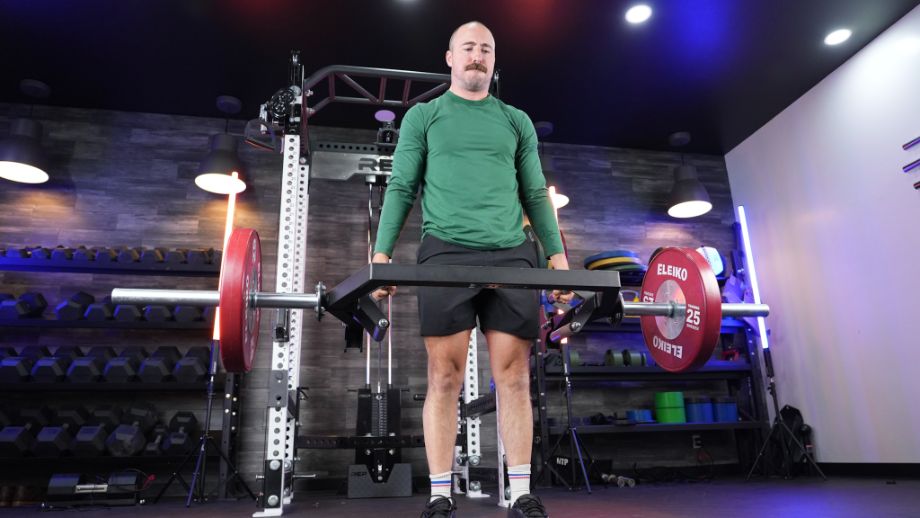
Do you ever need to carry groceries from the trunk to your kitchen? That’s the farmer’s carry. How about schlepping a bag or briefcase into the office? You got it: farmer’s carry.
RELATED: What Is Functional Fitness?
What about holding and carrying your toddler while they enthusiastically tell you about a bird they saw three days ago? That one’s technically not the farmer’s carry, but you’ll wind up using basically all of the same muscles, meaning the task will be easier if you’re used to doing farmer’s carries on the reg.
The best exercises train muscle groups that you need to move through your everyday life with ease. That’s exactly what you’ll get with the farmer’s carry.
It’s Strength and Cardio
As a strongman exercise, it’s a given that you can use the farmer’s carry to build strength, but did you know that it also produces a cardiovascular stimulus that helps you burn calories and lose weight?
A 2016 study in the Journal of Strength and Condition Research3 found that doing strongman exercises like the farmer’s walk “significantly elevated” the heart rates and fat expenditure of the study participants, suggesting that these exercises “could conceivably [improve] cardiovascular conditioning.”
So, forget about figuring out if you’re doing cardio or strength training first at the gym; do them simultaneously by working farmer’s walks into your training program!
Common Farmer’s Carry Mistakes
Just because the farmer’s carry involves picking up heavy objects and walking doesn’t mean you’re incapable of making mistakes.
Here are some of the most common mistakes associated with the farmer’s carry.
Tensing All the Wrong Places
The farmer’s carry requires contracting muscles in your upper back, core, legs, and more, but that doesn’t mean there’s no such thing as too much tension. In fact, tensing too hard in the wrong places may produce adverse effects.
“Mentally check that you’re not scrunching your neck, rounding your shoulders forward, arching your back, or locking out your knees while performing your farmer’s carry,” says Caine Wilkes, OLY, USAW-L1. “These characteristics usually indicate that you’re struggling to carry a load that’s too heavy for you.”
So, check in with your form before you start walking to relax the right muscles.
Choosing the Wrong Weight
Farmer’s carries should be heavy.
Going too light basically turns your farmer’s walk into, well, walking. Walking is still good if you’re a beginner or casual gym-goer, but it’s not going to get you the same results as an authentic farmer’s walk using heavy weights can.
On the flip side, going too heavy poses problems, too. Struggling to move weights that are too heavy may cause our form to deteriorate, leaving us susceptible to injury. Plus, it’s harder to hold onto heavy weights, and you’re bound to get less of a workout in the long run if you’re dropping the weights left and right.
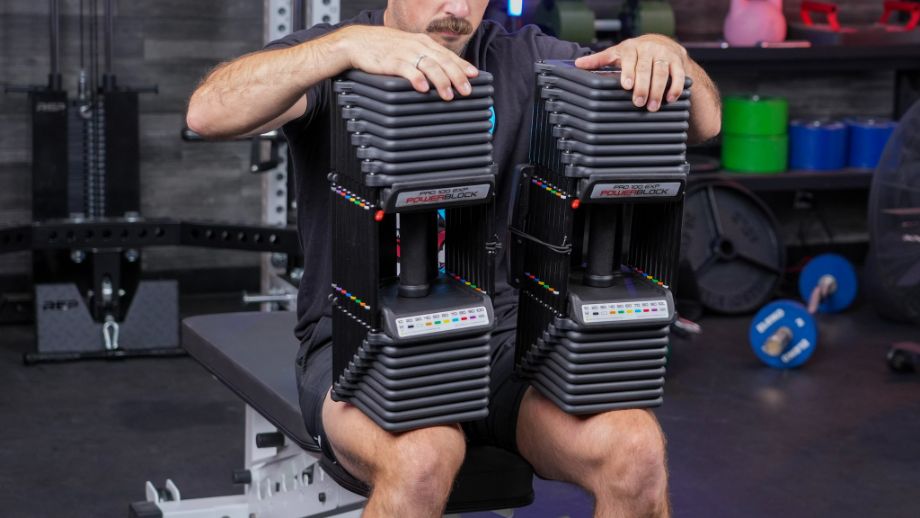
“Dumbbells that are approximately 25% of your body weight in each hand are a great place to start,” says Caine. “You may progress to lifting 50%, 75%, or even 100% of your body weight later on, but make sure you scale gradually.”
How to Program the Farmer’s Carry
The farmer’s carry is tricky to program because it differs from other exercises.
For example, you can tweak how you program a classic exercise like the bench press by simply increasing the number of sets, reps, or weight plates on the bar. Sets of farmer’s carries often consist of just one walk, making it trickier to progress.
Here’s how we would recommend incorporating the farmer’s carry into your workout:
- For strength gains: Perform 3–5 sets of 40 yards holding 50–75% of your body weight in each hand
- To build muscle: Perform 3–6 sets of 40 yards holding 25–50% of your bodyweight in each hand
- For endurance: Perform 2–3 sets of 80–100 yards holding 25% of your body weight in each hand
Farmer’s carries also work as part of a CrossFit-style WOD, pairing well with the push press, power clean, and more. For more fitspiration and personalized recommendations, consider working with a personal trainer.
RELATED: How Many Reps to Build Muscle
Who Should Do the Farmer’s Carry?
As a functional movement, everyone can benefit from incorporating farmer’s carries into their regular workout routine. They’re great for aspiring athletes, aging adults, and just about anyone looking to improve overall muscle mass, strength, and core stability.
Farmer’s Carry Variations
The farmer’s carry isn’t the only loaded carry you can add to your arsenal. Here are a few variations to help you keep things fresh.
Suitcase Carry
Why do it: The suitcase carry is essentially a unilateral exercise variation of the standard farmer’s carry. Giving your full attention to one side at a time holds the same benefits as the regular version, but you’ll also get increased oblique activation thanks to the one-sided loading.
How to do it:
- Grab one dumbbell or kettlebell and place it on the floor next to your ankle.
- Reach down to grip the weight and deadlift it to get it into position.
- Start walking in a straight line.
- Continue for the desired distance or duration, then rest.
- Switch sides and repeat the set.
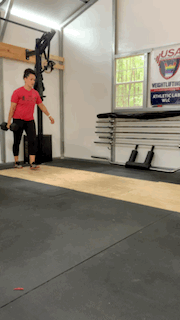
Trap-Bar Carry
Why do it: The trap bar’s unique shape helps reduce the strain on the lower back. Also, just how most lifters can move more weight on a barbell bench press versus the dumbbell version, trap-bar carries often allow you to carry more weight than you could using other free weights.
How to do it:
- Load a trap bar to the desired weight, then stand inside it.
- Reach down, grip the handles, and deadlift the bar.
- Start walking in a straight line.
- Continue for the desired distance or duration, then rest.
RELATED: Best Trap Bars
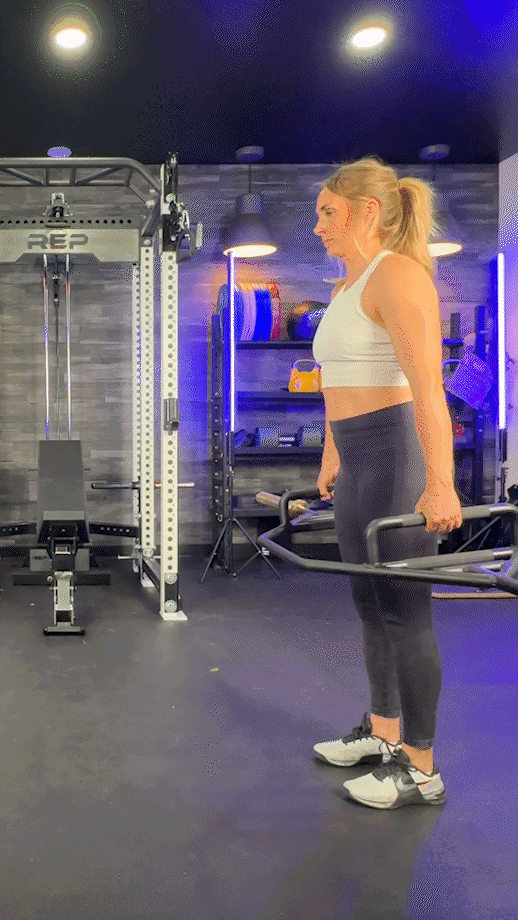
Zercher Carry
Why do it: The Zercher carry can be awkward or uncomfortable, but the strange positioning increases activation in your upper body, including the upper back and core muscles. If you’re really looking to build some big time upper body and core strength, the Zercher carry is a must.
How to do it:
- Rack an empty barbell at hip height and load it to the desired weight.
- Squat down so you can wedge the bar into the crooks of your elbows.
- Stand, clasping your hands together for extra stability.
- Start walking in a straight line.
- Continue for the desired distance or duration, then rest.
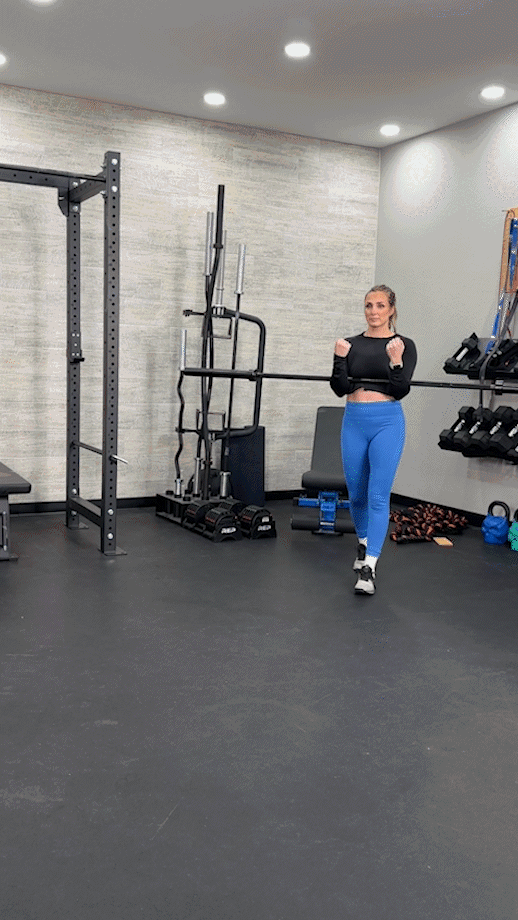
Farmer’s Carry: FAQs
How heavy should farmer’s carries be?
“As you progress, you can scale up to carry 50%, 75%, or even 100% of your body weight in each hand, but beginners should start with no more than 25% of their bodyweight held in each hand,” says Caine Wilkes, OLY, USAW-L1, and GGR staff writer. “That means a 150-pound individual would hold a 35- to 40-pound dumbbell in each hand after a few warm-up sets at lighter weights.”
Can you build muscle with the farmer’s carry?
Absolutely. You’ll want to combine your farmer’s carry with other movements that provide loads of muscle activation, as well as a protein-rich diet, supplements for muscle growth, and plenty of rest and recovery time. That said, the farmer’s carry by itself is effective for promoting hypertrophy.
What is a good distance for the farmer’s carry?
What’s good for a beginner might not be so good for a pro athlete, but, generally speaking, aiming for approximately 40 yards per carry, or 120 feet, is a great place to start.
References
1. Krzysztofik M, Wilk M, Wojdała G, Gołaś A. Maximizing Muscle Hypertrophy: A Systematic Review of Advanced Resistance Training Techniques and Methods. Int J Environ Res Public Health. 2019;16(24):4897. Published 2019 Dec 4. doi:10.3390/ijerph16244897
2. Park HS, Park SW, Oh JK. Effect of adding abdominal bracing to spinal stabilization exercise on lumbar lordosis angle, extensor strength, pain, and function in patients with non-specific chronic low back pain: A prospective randomized pilot study. Medicine (Baltimore). 2023;102(41):e35476. doi:10.1097/MD.0000000000035476
3. Harris NK, Woulfe CJ, Wood MR, Dulson DK, Gluchowski AK, Keogh JB. Acute Physiological Responses to Strongman Training Compared to Traditional Strength Training. J Strength Cond Res. 2016;30(5):1397-1408. doi:10.1519/JSC.0000000000001217


